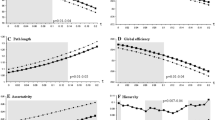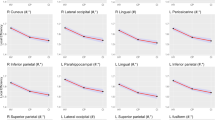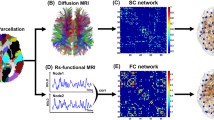Abstract
Cognitive dysfunction in multiple sclerosis (MS) seems to be the result of neural disconnections, leading to a wide range of brain functional network alterations. It is assumed that the analysis of the topological structure of brain connectivity network can be used to assess cognitive impairments in MS disease. We aimed to identify these brain connectivity pattern alterations and detect the significant features for the distinction of MS patients from healthy controls (HC). In this regard, the importance of functional brain networks construction for better exhibition of changes, inducing the improved reflection of functional organization structure should be precisely considered. In this paper, we strove to introduce a framework for modeling the functional connectivity network by considering the two most important intrinsic sparse and modular structures of brain. For the proposed approach, we first derived group-wise sparse representation via learning a common over-complete dictionary matrix from the aggregated cognitive task-based functional magnetic resonance imaging (fMRI) data of all subjects of the two groups to be able to investigate between-group differences. We then applied the modularity concept on achieved sparse coefficients to compute the connectivity strength between the two brain regions. We examined the changes in network topological properties between relapsing–remitting MS (RRMS) and matched HC groups by considering the pairwise connections of regions of the resulted weighted networks and extracting graph-based measures. We found that the informative brain regions were related to their important connectivity weights, which could distinguish MS patients from the healthy controls. The experimental findings also proved the discrimination ability of the modularity measure among all the global features. In addition, we identified such local feature subsets as eigenvector centrality, eccentricity, node strength, and within-module degree, which significantly differed between the two groups. Moreover, these nodal graph measures have been served as the detectors of brain regions, affected by different cognitive deficits. In general, our findings illustrated that integration of sparse representation, modular structure, and pairwise connectivity strength in combination with the graph properties could help us with the early diagnosis of cognitive alterations in the case of MS.








Similar content being viewed by others
References
Mainero C et al (2004) fMRI evidence of brain reorganization during attention and memory tasks in multiple sclerosis. Neuroimage 21(3):858–867
Gamboa OL et al (2014) Working memory performance of early MS patients correlates inversely with modularity increases in resting state functional connectivity networks. Neuroimage 94:385–395
Baysal Kıraç L, Ekmekçi Ö, Yüceyar N, Kocaman AS (2014) Assessment of early cognitive impairment in patients with clinically isolated syndromes and multiple sclerosis. Behav Neurol 2014:637694
Audoin B et al (2005) Magnetic resonance study of the influence of tissue damage and cortical reorganization on PASAT performance at the earliest stage of multiple sclerosis. Hum Brain Mapp 24(3):216–228
He BJ, Shulman GL, Snyder AZ, Corbetta M (2007) The role of impaired neuronal communication in neurological disorders. Curr Opin Neurol 20(6):655–660
Guye M, Bartolomei F, Ranjeva J-P (2008) Imaging structural and functional connectivity: towards a unified definition of human brain organization? Curr Opin Neurol 21(4):393–403
Bonavita S et al (2011) Distributed changes in default-mode resting-state connectivity in multiple sclerosis. Mult Scler J 17(4):411–422
Sporns O, Chialvo DR, Kaiser M, Hilgetag CC (2004) Organization, development and function of complex brain networks. Trends Cogn Sci 8(9):418–425
Supekar K, Menon V, Rubin D, Musen M, Greicius MD (2008) Network analysis of intrinsic functional brain connectivity in Alzheimer's disease. PLoS Comput Biol 4(6):e1000100
Khazaee A, Ebrahimzadeh A, Babajani-Feremi A (2016) Application of advanced machine learning methods on resting-state fMRI network for identification of mild cognitive impairment and Alzheimer’s disease. Brain Imaging Behav 10(3):799–817
Onias H et al (2014) Brain complex network analysis by means of resting state fMRI and graph analysis: will it be helpful in clinical epilepsy? Epilepsy Behav 38:71–80
Eqlimi E et al (2014) Resting state functional connectivity analysis of multiple sclerosis and neuromyelitis optica using graph theory. In: XIII Mediterranean Conference on medical and biological engineering and computing 2013. Springer, pp 206–209
Ashtiani SNM et al (2018) Altered topological properties of brain networks in the early MS patients revealed by cognitive task-related fMRI and graph theory. Biomed Signal Process Control 40:385–395
Eguiluz VM, Chialvo DR, Cecchi G, Baliki M, Apkarian AV (2004) Scale-free brain functional networks. Neuroimage 22:2330
Rubinov M, Sporns O (2010) Complex network measures of brain connectivity: uses and interpretations. Neuroimage 52(3):1059–1069
Van Den Heuvel MP, Pol HEH (2010) Exploring the brain network: a review on resting-state fMRI functional connectivity. Eur Neuropsychopharmacol 20(8):519–534
Hampson M, Peterson BS, Skudlarski P, Gatenby JC, Gore JC (2002) Detection of functional connectivity using temporal correlations in MR images. Hum Brain Mapp 15(4):247–262
Power JD et al (2011) Functional network organization of the human brain. Neuron 72(4):665–678
Wee C-Y et al (2012) Resting-state multi-spectrum functional connectivity networks for identification of MCI patients. PLoS ONE 7(5):e37828
Murrough JW et al (2016) Reduced global functional connectivity of the medial prefrontal cortex in major depressive disorder. Hum Brain Mapp 37(9):3214–3223
Khazaee A, Ebrahimzadeh A, Babajani-Feremi A (2016) Classification of patients with MCI and AD from healthy controls using directed graph measures of resting-state fMRI. Behav Brain Res 30:339
Wang X, Ren Y, Zhang W (2017) Depression disorder classification of fmri data using sparse low-rank functional brain network and graph-based features. Comput Math Methods Med 2017:3609821
Yu R, Zhang H, An L, Chen X, Wei Z, Shen D (2017) Connectivity strength-weighted sparse group representation-based brain network construction for Mci classification. Hum Brain Mapp 38(5):2370–2383
McKeown MJ et al (1997) Analysis of fMRI data by blind separation into independent spatial components. Naval Health Research Center, San Diego
Esposito F et al (2002) Spatial independent component analysis of functional MRI time-series: to what extent do results depend on the algorithm used? Hum Brain Mapp 16(3):146–157
Rocca M et al (2010) Default-mode network dysfunction and cognitive impairment in progressive MS. Neurology 74(16):1252–1259
Roosendaal SD et al (2010) Resting state networks change in clinically isolated syndrome. Brain 133(6):1612–1621
Olshausen BA, Field DJ (1996) Emergence of simple-cell receptive field properties by learning a sparse code for natural images. Nature 381(6583):607
Daubechies I et al (2009) Independent component analysis for brain fMRI does not select for independence. Proc Natl Acad Sci 106(26):10415–10422
Lee K, Tak S, Ye JC (2011) A data-driven sparse GLM for fMRI analysis using sparse dictionary learning with MDL criterion. IEEE Trans Med Imaging 30(5):1076–1089
Stam C, Jones B, Nolte G, Breakspear M, Scheltens P (2007) Small-world networks and functional connectivity in Alzheimer's disease. Cereb Cortex 17(1):92–99
Fransson P (2005) Spontaneous low-frequency BOLD signal fluctuations: an fMRI investigation of the resting-state default mode of brain function hypothesis. Hum Brain Mapp 26(1):15–29
Huang S et al (2010) Learning brain connectivity of Alzheimer's disease by sparse inverse covariance estimation. NeuroImage 50(3):935–949
Wan J et al (2014) Identifying the neuroanatomical basis of cognitive impairment in Alzheimer's disease by correlation-and nonlinearity-aware sparse Bayesian learning. IEEE Trans Med Imaging 33(7):1475–1487
Lee Y-B et al (2016) Sparse SPM: group sparse-dictionary learning in SPM framework for resting-state functional connectivity MRI analysis. Neuroimage 125:1032–1045
Lee J, Jeong Y, and Ye JC (2013) Group sparse dictionary learning and inference for resting-state fMRI analysis of Alzheimer's disease. In: 2013 IEEE 10th International Symposium on biomedical imaging (ISBI). IEEE, pp. 540–543
Wee C-Y, Yap P-T, Zhang D, Wang L, Shen D (2014) Group-constrained sparse fMRI connectivity modeling for mild cognitive impairment identification. Brain Struct Funct 219(2):641–656
Newman ME (2004) Fast algorithm for detecting community structure in networks. Phys Rev E 69(6):066133
Newman ME (2006) Modularity and community structure in networks. Proc Natl Acad Sci 103(23):8577–8582
Wechsler D (1987) Wechsler memory scale-revised manual. Psychological Cooperation Inc., New York
Stroop J (1935) Studies of interference in serial verbal reactions. J Experiment Psychol 18:643–661
Petsas N (2012) Brain’s functional connectivity alterations in multiple sclerosis: an fMRI investigation (Doctoral dissertation, Department of Phycology, Sapienza Università di Roma). http://hdl.handle.net/10805/2013
Smith SM, Jenkinson M, Woolrich MW, Beckmann CF, Behrens TE, Johansen-Berg H et al (2004) Advances in functional and structural MR image analysisand implementation as FSL. Neuroimage 23:S208–S219
Woolrich MW, Jbabdi S, Patenaude B, Chappell M, Makni S, Behrens T et al (2009) Bayesian analysis of neuroimaging data in FSL. Neuroimage 45(1):S173–S186
Jenkinson M, Beckmann CF, Behrens TE, Woolrich MW, Smith SM (2012) Fsl. Neuroimage 62(2):782–790
Smith SM (2002) Fast robust automated brain extraction. Hum Brain Mapp 17(3):143–155
Jenkinson M, Bannister P, Brady M, Smith S (2002) Improved optimization for therobust and accurate linear registration and motion correction of brain images. Neuroimage 17(2):825–841
Jenkinson M, Smith S (2001) A global optimisation method for robust affineregistration of brain images. Med Image Anal 5(2):143–156
Li Y, Namburi P, Yu Z, Guan C, Feng J, Gu Z (2009) Voxel selection in fMRI data analysis based on sparse representation. IEEE Trans Biomed Eng 56(10):2439–2451
Li Y, Long J, He L, Lu H, Gu Z, Sun P (2012) A sparse representation-based algorithm for pattern localization in brain imaging data analysis. PLoS ONE 7(12):e50332
Oikonomou VP, Blekas K, Astrakas L (2012) A sparse and spatially constrained generative regression model for fMRI data analysis. IEEE Trans Biomed Eng 59(1):58–67
Tzourio-Mazoyer N et al (2002) Automated anatomical labeling of activations in SPM using a macroscopic anatomical parcellation of the MNI MRI single-subject brain. Neuroimage 15(1):273–289
Mairal J, Bach F, Ponce J, Sapiro G (2010) Online learning for matrix factorization and sparse coding. J Mach Learn Res 11:19–60
Lv J et al (2015) Sparse representation of whole-brain fMRI signals for identification of functional networks. Med Image Anal 20(1):112–134
Friston KJ, Holmes AP, Worsley KJ, Poline JP, Frith CD, Frackowiak RS (1994) Statistical parametric maps in functional imaging: a general linear approach. Hum Brain Mapp 2(4):189–210
Van Schependom J, Gielen J, Laton J, D’hooghe MB, De Keyser J, Nagels G (2014) Graph theoretical analysis indicates cognitive impairment in MS stems from neural disconnection. NeuroImage 4:403–410
Genovese CR, Lazar NA, Nichols T (2002) Thresholding of statisticalmaps in functional neuroimaging using the false discovery rate. Neuro-image 15:870–878
Liu Y, Duan Y, Dong H, Barkhof F, Li K, Shu N (2018) Disrupted module efficiency of structural and functional brain connectomes in clinically isolated syndrome and multiple sclerosis. Front Hum Neurosci 12:138
Girvan M, Newman ME (2002) Community structure in social and biological networks. Proc Natl Acad Sci 99(12):7821–7826
Danon L, Diaz-Guilera A, Duch J, Arenas A (2005) Comparing community structure identification. J Stat Mech 2005(09):P09008
Catani M, Jones DK (2005) Perisylvian language networks of the human brain. Ann Neurol 57(1):8–16
de Haan W, van der Flier WM, Koene T, Smits LL, Scheltens P, Stam CJ (2012) Disrupted modular brain dynamics reflect cognitive dysfunction in Alzheimer's disease. Neuroimage 59(4):3085–3093
Buldú JM et al (2011) Reorganization of functional networks in mild cognitive impairment. PLoS ONE 6(5):e19584
Bonacich P (1972) Factoring and weighting approaches to status scores and clique identification. J Math Sociol 2(1):113–120
Bonacich P (2007) Some unique properties of eigenvector centrality. Soc Netw 29(4):555–564
Hardmeier M et al (2012) Cognitive dysfunction in early multiple sclerosis: altered centrality derived from resting-state functional connectivity using magneto-encephalography. PLoS ONE 7(7):e42087
Binnewijzend MA et al (2014) Brain network alterations in Alzheimer's disease measured by Eigenvector centrality in fMRI are related to cognition and CSF biomarkers. Hum Brain Mapp 35(5):2383–2393
Hojjati SH, Ebrahimzadeh A, Khazaee A, Babajani-Feremi A, Initiative ASDN (2017) Predicting conversion from MCI to AD using resting-state fMRI, graph theoretical approach and SVM. J Neurosci Methods 282:69–80
Harris JM, Hirst JL, Mossinghoff MJ (2008) Combinatorics and graph theory. Springer, New York
Tewarie P et al (2014) Functional brain network analysis using minimum spanning trees in multiple sclerosis: an MEG source-space study. Neuroimage 88:308–318
Menon V (2013) Developmental pathways to functional brain networks: emerging principles. Trends Cogn Sci 17(12):627–640
de Haan W, Mott K, van Straaten EC, Scheltens P, Stam CJ (2012) Activity dependent degeneration explains hub vulnerability in Alzheimer's disease. PLoS Comput Biol 8(8):e1002582
Mangeat G et al (2018) Changes in structural network are associated with cortical demyelination in early multiple sclerosis. Hum Brain Mapp 39:2133
Vercellino M, Plano F, Votta B, Mutani R, Giordana MT, Cavalla P (2005) Grey matter pathology in multiple sclerosis. J Neuropathol Exp Neurol 64(12):1101–1107
Lucchinetti CF et al (2011) Inflammatory cortical demyelination in early multiple sclerosis. N Engl J Med 365(23):2188–2197
Gilmore CP, Donaldson I, Bö L, Owens T, Lowe J, Evangelou N (2009) Regional variations in the extent and pattern of grey matter demyelination in multiple sclerosis: a comparison between the cerebral cortex, cerebellar cortex, deep grey matter nuclei and the spinal cord. J Neurol Neurosurg Psychiatry 80(2):182–187
Rocca MA et al (2014) Functional correlates of cognitive dysfunction in multiple sclerosis: a multicenter fMRI Study. Hum Brain Mapp 35(12):5799–5814
Tüdös Z, Hok P, Hrdina L, Hluštík P (2014) Modality effects in paced serial addition task: Differential responses to auditory and visual stimuli. Neuroscience 272:10–20
Spiteri S, Hassa T, Claros-Salinas D, Schoenfeld M, and Dettmers C (2016) Functional MRI changes illustrating cognitive fatigue in patients with multiple sclerosis, vol 25. Rehabilitationswissenschaftliches Kolloquium, p. 370.
Cabeza R, Nyberg L (2000) Imaging cognition II: an empirical review of 275 PET and fMRI studies. J Cogn Neurosci 12(1):1–47
Roosendaal SD et al (2010) Structural and functional hippocampal changes in multiple sclerosis patients with intact memory function. Radiology 255(2):595–604
Cruz-Gómez Á, Belenguer-Benavides A, Martinez-Bronchal B, Fittipaldi-Márquez M, Forn C (2016) Structural and functional changes of the hippocampus in patients with multiple sclerosis and their relationship with memory processes. Rev Neurol 62(1):6–12
Eichenbaum H, Dudchenko P, Wood E, Shapiro M, Tanila H (1999) The hippocampus, memory, and place cells: is it spatial memory or a memory space? Neuron 23(2):209–226
Squire LR (1992) Memory and the hippocampus: a synthesis from findings with rats, monkeys, and humans. Psychol Rev 99(2):195
Suarez AN, Noble EE, Kanoski SE (2019) Regulation of memory function by feeding-relevant biological systems: following the breadcrumbs to the hippocampus. Front Mol Neurosci 12:101
Moscovitch M, Cabeza R, Winocur G, Nadel L (2016) Episodic memory and beyond: the hippocampus and neocortex in transformation. Annu Rev Psychol 67:105–134
Ragland JD, Layher E, Hannula DE, Niendam TA, Lesh TA, Solomon M, Carter CS, Ranganath C (2017) Impact of schizophrenia on anterior and posterior hippocampus during memory for complex scenes. NeuroImage 13:82–88
Moscovitch M, Nadel L, Winocur G, Gilboa A, Rosenbaum RS (2006) The cognitive neuroscience of remote episodic, semantic and spatial memory. Curr Opin Neurobiol 16(2):179–190
Burgess N, Maguire EA, O'Keefe J (2002) The human hippocampus and spatial and episodic memory. Neuron 35(4):625–641
Klur S, Muller C, Pereira de Vasconcelos A, Ballard T, Lopez J, Galani R, Certa U, Cassel JC (2009) Hippocampal-dependent spatial memory functions might be lateralized in rats: an approach combining gene expression profiling and reversible inactivation. Hippocampus 19(9):800–816
Geurts JJ, Bö L, Roosendaal SD, Hazes T, Daniëls R, Barkhof F, Witter MP, Huitinga I, van der Valk P (2007) Extensive hippocampal demyelination in multiple sclerosis. J Neuropathol Exp Neurol 66(9):819–827
Zhou Y, Dougherty JH Jr, Hubner KF, Bai B, Cannon RL, Hutson RK (2008) Abnormal connectivity in the posterior cingulate and hippocampus in early Alzheimer's disease and mild cognitive impairment. Alzheimer's Dementia 4(4):265–270
Leonardi N, Richiardi J, and Van De Ville D (2013) Functional connectivity eigennetworks reveal different brain dynamics in multiple sclerosis patients. In: 2013 IEEE 10th International Symposium on biomedical imaging (ISBI). IEEE, pp 528–531
Forn C et al (2006) Cortical reorganization during PASAT task in MS patients with preserved working memory functions. Neuroimage 31(2):686–691
Acknowledgements
This research has been financially supported by the Iran Neural Technology Research Center, Iran University of Science and Technology, Tehran, Iran under Grant 48. M.111194.
Author information
Authors and Affiliations
Corresponding author
Ethics declarations
Conflict of interest
The authors declare that they have no conflict of interest.
Ethical approval
All procedures performed in studies involving human participants were in accordance with the ethical standards of the institutional and/or national research committee and with the 1964 Helsinki declaration and its later amendments or comparable ethical standards.
Informed consent
Informed consent was obtained from all individual participants included in the study.
Additional information
Publisher's Note
Springer Nature remains neutral with regard to jurisdictional claims in published maps and institutional affiliations.
Electronic supplementary material
Below is the link to the electronic supplementary material.
Rights and permissions
About this article
Cite this article
Miri Ashtiani, S.N., Behnam, H., Daliri, M.R. et al. Analysis of brain functional connectivity network in MS patients constructed by modular structure of sparse weights from cognitive task-related fMRI. Australas Phys Eng Sci Med 42, 921–938 (2019). https://doi.org/10.1007/s13246-019-00790-1
Received:
Accepted:
Published:
Issue Date:
DOI: https://doi.org/10.1007/s13246-019-00790-1




